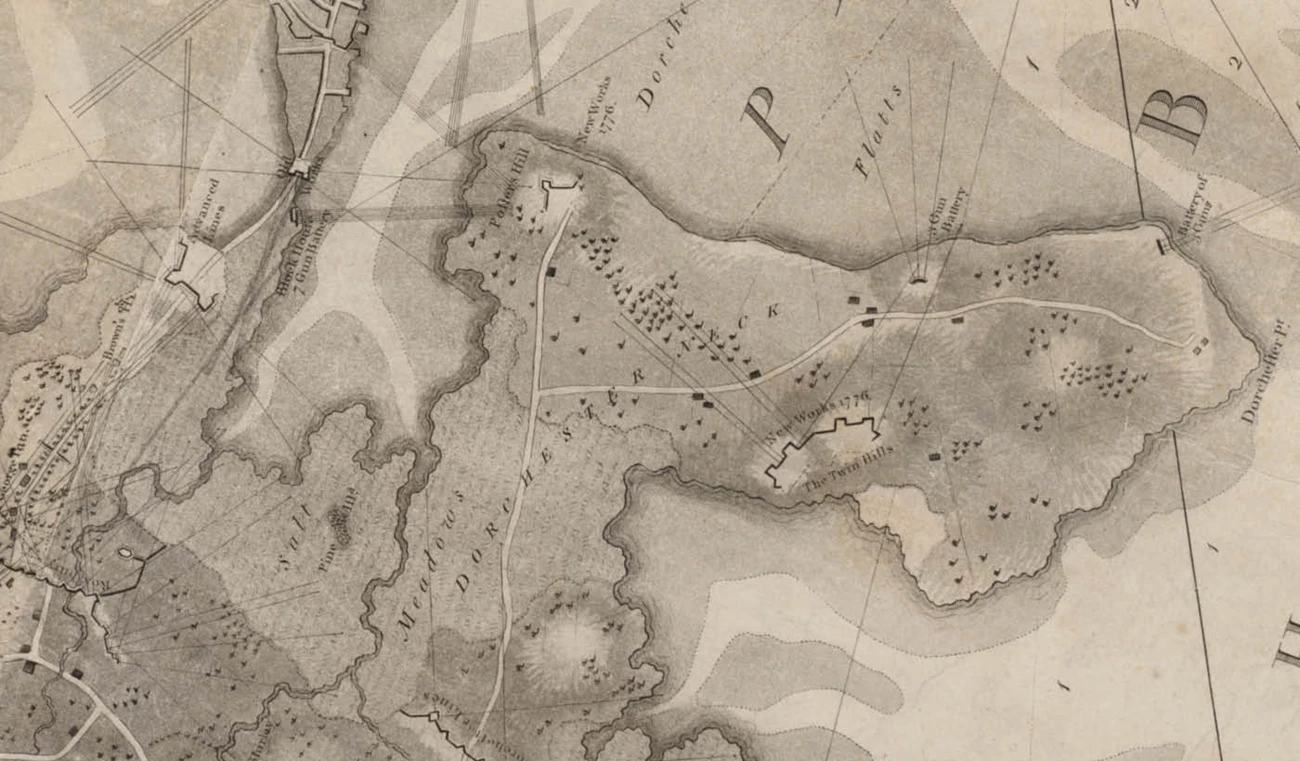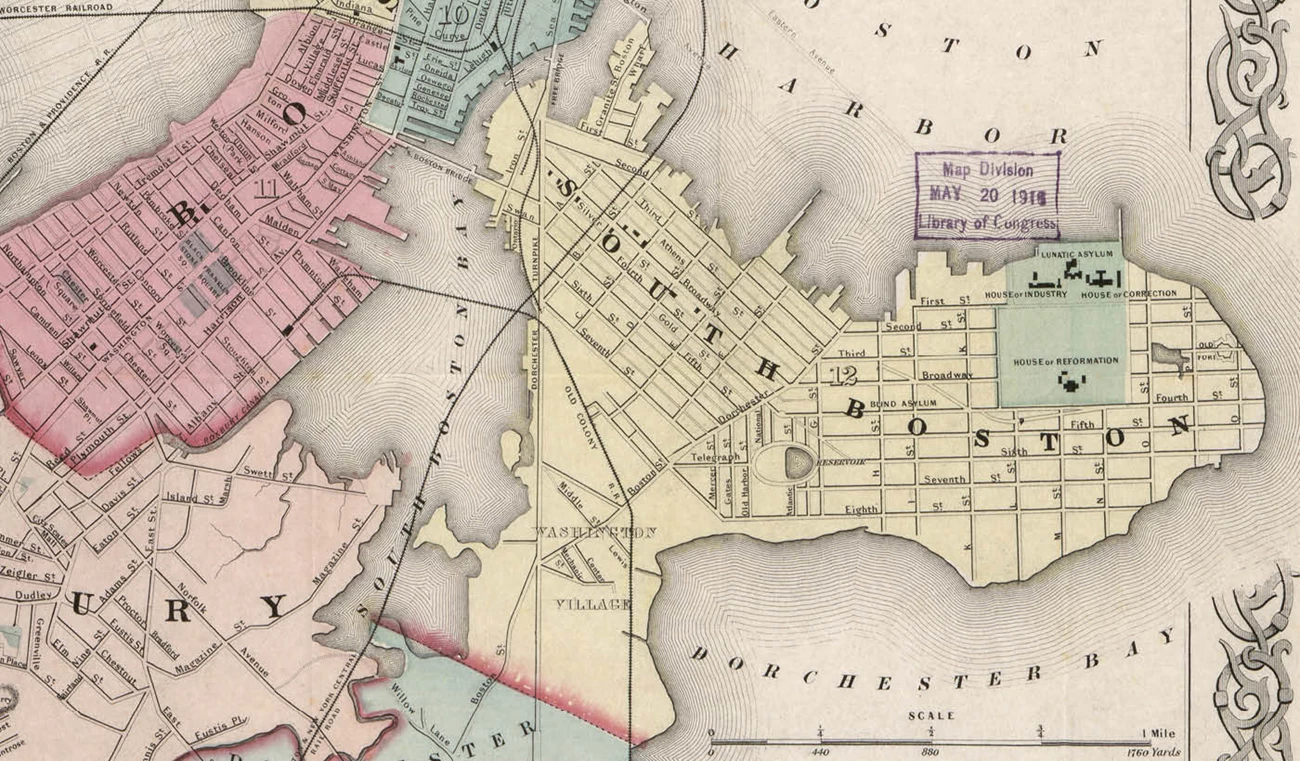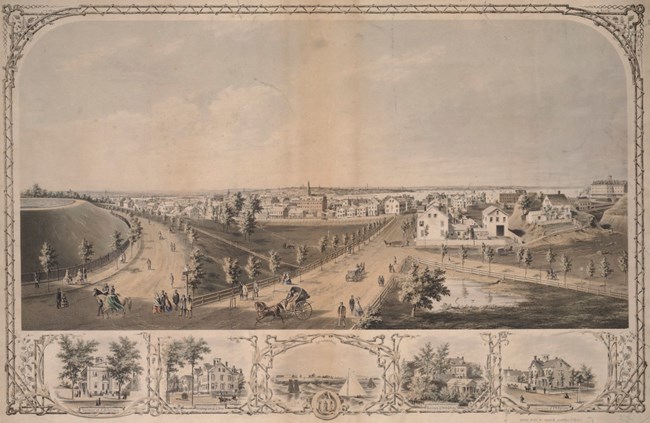Last updated: May 30, 2024
Article
Transforming Telegraph Hill and Remembering Dorchester Heights
This article is part of the series "Desegregation in the Cradle of Liberty." This series explores the Black struggle for equal education in Boston from 1787 to 1976, culminating with protests and violence experienced under forced busing in Boston in the 1970s.
Throughout the 1800s, Boston’s population grew steadily. Industrialization, railroads, and shipping, combined with constant immigration, saw Boston grow both in terms of population as well as in size. In 1804, Boston annexed an area called the Dorchester Peninsula from the then-separate town of Dorchester.[1] Within just a few decades, it became the rapidly developing neighborhood known as South Boston. Irish Catholic immigrants comprised the largest of any ethnic group to immigrate to Boston in the 1800s, and South Boston quickly became a dominantly Irish American enclave.


Left image
Map of Boston in 1776
Credit: Digital Commonwealth
Right image
Map of South Boston in 1856
Credit: Library of Congress
As a neighborhood of a rapidly urbanizing city, residents could expect far greater services and infrastructure than that of a small town. Nonetheless, budget and political constraints of administrating an increasingly expansive city also presented difficulties in ensuring equitable access. Telegraph Hill, the tallest hill in South Boston, represented and bore witness to such neighborhood struggles.

Boston Public Library
Underdeveloped and towering over the rest of the area, South Boston’s Telegraph Hill proved an ideal location for a reservoir for the new public water system for the entire city. Because of the hill’s strategic height, George Washington’s army fortified it during the Siege of Boston in 1775/1776. During the War of 1812, the military once again fortified this hill to protect Boston Harbor. Remnants of those fortifications could still be seen when construction of the reservoir began in the 1850s. A new park, Thomas Park, shared the hill with the new reservoir. Because developers rapidly built up the surrounding area, soon this site became the only open space for residents.[2]
By the 1890s, the largely working-class Irish American community of South Boston campaigned for its own high school to meet the needs of their children. Prior to this time, students in the neighborhood had to travel elsewhere in the city for upper-level education. Residents leveraged their connections in local government, which had become increasingly dominated by Irish Americans, to help advocate for this much needed new school. They held public forums where the residents voiced their concerns regarding the education of their children. For example, at one forum in 1894, South Bostonian Charles M. Bromwich stated:
If there is any section of the city that needs looking after for a high school that place is South Boston. It is our right to have our children educated here if we want them to be.[3]
After years of advocacy, South Boston parents and their supporters succeeded in getting the City to agree to a new high school for South Boston. However, the cost of procuring land threatened to take up too much of the overall budget. Rather than use eminent domain or individual property purchases, the City saw a cost saving opportunity by using the reservoir site on Telegraph Hill. By the 1890s, the City no longer needed the reservoir and since it already owned the property, there would be significant cost savings. Many residents preferred less hilly locations more centrally located to the neighborhood. Nonetheless, after the City made it clear that the reservoir site provided the only available option, the neighborhood largely accepted the choice to finally get their local high school.
Yet even beyond the neighborhood of South Boston, the announced location of the high school proved controversial. Boston’s Protestant elite felt that the newer Irish Catholic immigrants did not fully appreciate the historical significance of the site of Dorchester Heights during the American Revolutionary War.
Representative John J. Toomey stated:
With a high school on the reservoir lot historical Dorchester Heights would be no more.[4]
The Honorable William S. McNary shared:
Therefore I say that Dorchester Heights should not be destroyed in any way. It should be preserved to be a patriotic lesson to people young and old; it should be preserved for the opportunities offered in securing fresh air which many poor people are otherwise unable to get.[5]

The Boston Globe, March 19, 1901
In the end, both communities reached a compromise. South Bostonians received their high school on one side of the hill, and Boston’s elite won plans to install a new monument tower dedicated to Dorchester Heights and the American Revolution on the other side of the hill. The City of Boston also established a new annual city-wide holiday, Evacuation Day, on March 17 to mark the British retreat from Boston in 1775. The South Boston Irish American community fully embraced this new tradition, combining Evacuation Day ceremonies with their Saint Patrick’s Day celebration, which culminated in a parade up to the Monument. [6]
South Boston High School opened to much fanfare in 1901, a result of the concerted efforts of the community and their allies in the political establishment of the city.
In the 1970s, however, South Boston High School became a focal point in the contentious, and often violent, protests over the desegregation of the Boston Public Schools.
Overview Timeline Article
Black Struggle for Equal EducationFootnotes
[1] Acts and Resolves of Massachusetts, 1803, January Session, Chapter 111.
[2] Nathaniel Jeremiah Bradlee, History of the Introduction of Pure Water Into the City of Boston: With a Description of Its Cochituate Water Works, (Massachusetts: Cochituate Water Board, 1868).
[3] "For High School South Bostonites Meet and Gives Views," The Boston Globe, February 16, 1894.
[4] "What Location Does South Boston Desire for High School? Shall New Structure by Placed on Dorchester Hights, Or Shall that Spot Forever Be Preserved As Recreation Ground and Historical Landmark? What People of Peninsula Have to Say on Subject," The Boston Globe, March 20, 1897.
[5] "What Location Does South Boston Desire for High School? Shall New Structure by Placed on Dorchester Hights, Or Shall that Spot Forever Be Preserved As Recreation Ground and Historical Landmark? What People of Peninsula Have to Say on Subject," The Boston Globe, March 20, 1897.
[6] "British Eviction Celebrated: South Boston the Center of Patriotic Evacuation Day Festivities," The Boston Globe, March 19, 1901.

